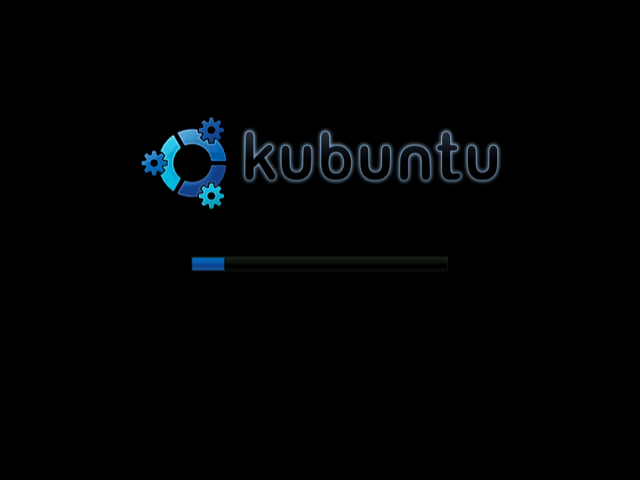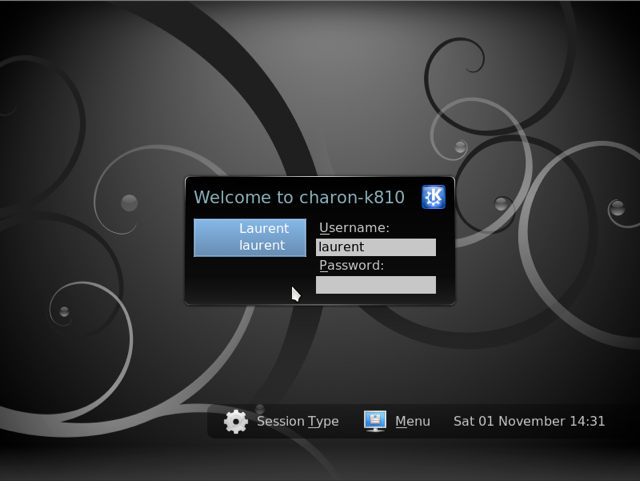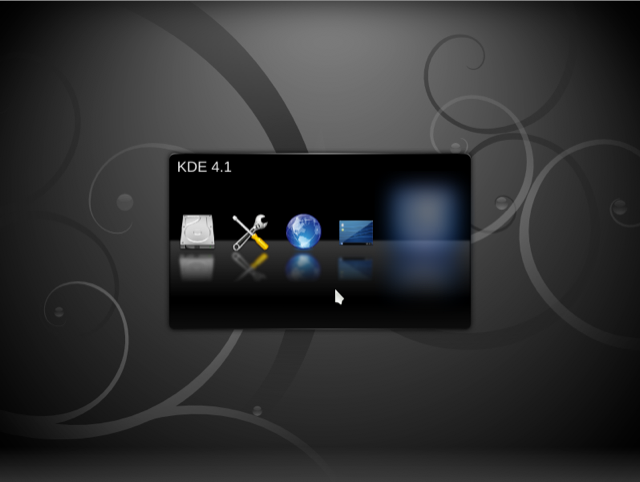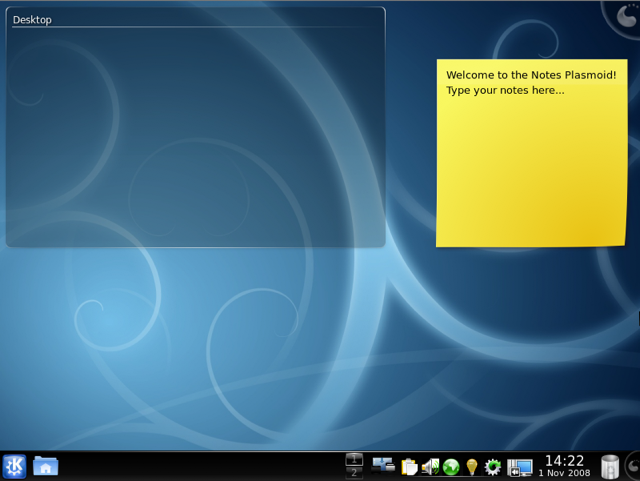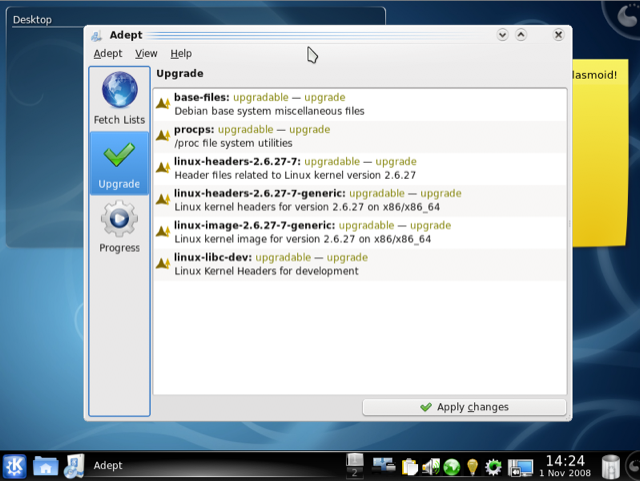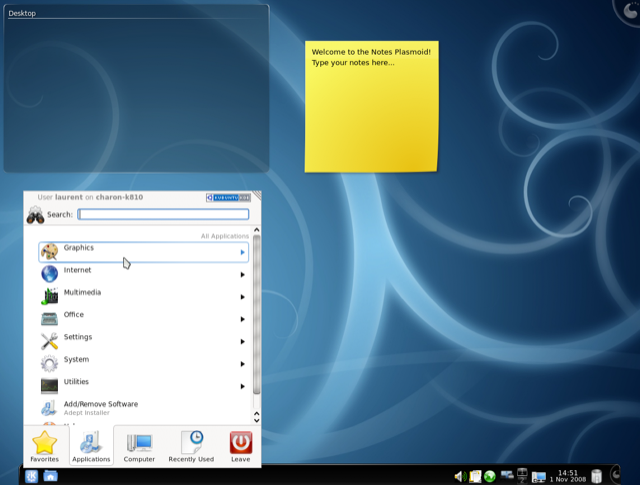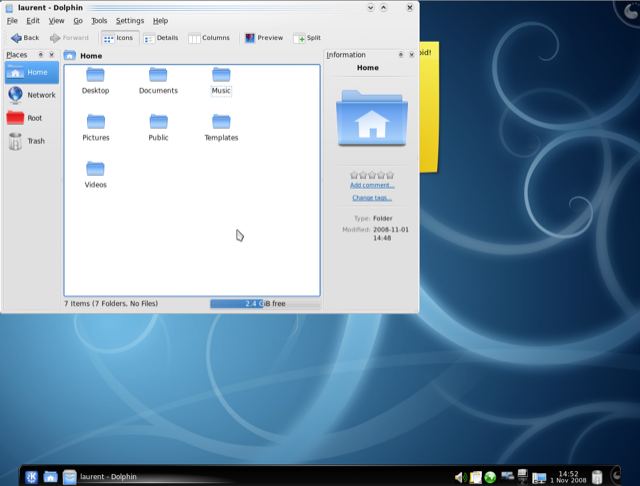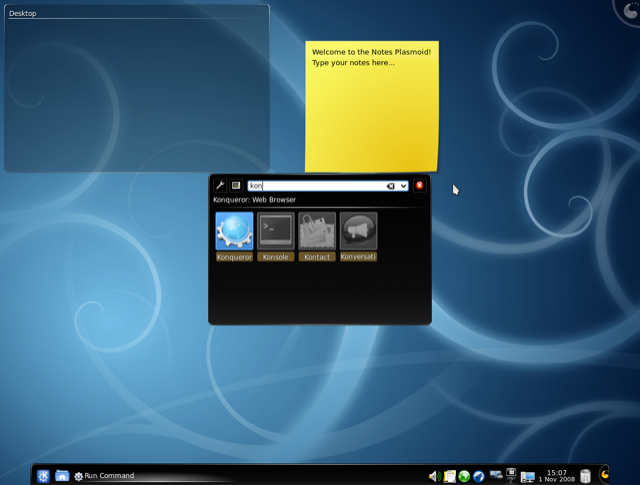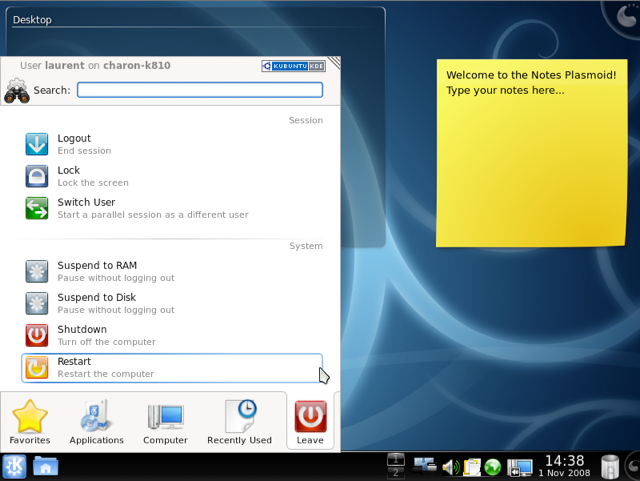Kubuntu 8.10
Last week Kubuntu 8.10 was released. Like OpenBSD, there is a new release every 6 months.
Kubuntu is a Linux distribution based on Ubuntu (which is based on Debian). Kubuntu is Ubuntu but the default desktop environment is KDE instead of Gnome.
The big improvement compared to Kubuntu 8.04 is the new version of KDE (4.1 instead of 3.x). KDE 4 is a major rewrite of KDE with a lot of improvements. Version 4.0 was mostly aiming at developers but version 4.1 is now suitable for regular users.
Installation
I downloaded the CD on BitTorrent and installed it on a virtual machine (with Sun's VirtualBox).
The CD allows you to boot on the live CD, and install Kubuntu from the live CD, or to directly start the installation process.
Only few questions are asked:
- Your language (Kubuntu is translated in a lot of different languages).
- Your time zone.
- Your keyboard layout.
- How to set up your hard drive (since I wanted to use the full disk, I just had to click on
next, this is the only tricky part of the installation). - Your name, login and the name you want to give to your computer.
Then the installation start. Disk partitioning, formatting, packages installation. You just have to wait.
At the end, reboot, that's done.
First boot
The boot screen is still the same, with the same progress bar as in previous versions.
The new login screen is very nice (well, I like it) except the list of the users on the left (providing a default picture for each user should fill that blank part and make it better looking).
Then you have to wait a bit more while KDE is loading your session (nice loading animation).
At last, the desktop.
No more icons on the desktop. All the files that were on it are now displayed on the "Desktop" plasmoid. Plasmoids are KDE's applets, equivalent of Mac OS's widgets or Windows Vista's gadgets.
Not long after you logged in, a notification tells that updates are already available. So let's have a look.
Adept is launched. It's the graphical software you will use to install or remove softwares and upgrade installed softwares.
The interface is way much better than the one provided in the previous version of Kubuntu.
Let's have a look at the K menu.
Interesting, everything is displayed in the same window, there are no sub-menus opening on the side. It's cleaner, not sure if it's very useful. They have done a lot of usability tests on it, but the gain is not obvious. Anyway, I usually don't use the K menu (maybe that's why I don't see all the improvements in it ;-)).
I have tried a beta version few month ago and there was a thing a bit better, I didn't had to click to move between the panels. After a quick look (right click on the K menu), there are some options: use the classic menu (for those who don't like the new one), and change panels without clicking. KDE was known to have a lot of options everywhere, this version kept that spirit.
Right next to the K menu is an "home" folder icon. A click on it will allow you to quickly navigate inside your home folder.
In KDE, a piece a software was central for the user: Konqueror. Konqueror was used as a web browser but it was also used as a file manager. Konqueror is very versatile, with a huge amount of options. You can browse web pages, your local hard drive, any disks, FTP, remote SSH/SFTP, audio CD (even extract music from audio CD in the simplest way I have ever seen), all that the same way.
In the late version of KDE 3, a new file manager called Dolphin. At first I didn't understand why. There was no lawsuit against KDE forcing them to separate the file manager from the web browser ;-), and Konqueror was just fine.
After using Dolphin a bit, I have to admit that it's great. Focusing on mostly one task: browse files, Dolphin is a simpler tool, pleasant to use. However, Konqueror is still used as the web browser.
I said that I do not use the K menu a lot. At least, I don't use it to launch applications. I know the name of the applications I want to use, and using the keyboard can be faster than the mouse. On KDE 3, I used an application call Katapult. Hit a keyboard shortcut, a window appear, start typing the name of the application. Katapult list applications whose name is starting with the same letters. Hit enter and the application is launched. Very fast and convenient way to launch applications.
In KDE 4, no need for Katapult anymore. KRunner has been given the same functionality (hit Alt+F2 to launch it).
A lot more can be told about KDE 4, the amount of changes is impressive. I installed it on a virtual machine, now I want to install it on a real computer, to see the full potential of it, to be able to play with all the new stuff using graphic acceleration (not available on my VM :-().
Let's switch it off for now.
I used KDE 4.1 just for few hours but I think it's a very cool desktop environment. There are still some glitches, some improvements can be done, but it's already very nice.
KDE 4.2 is already under heavy development, more improvements are coming.


